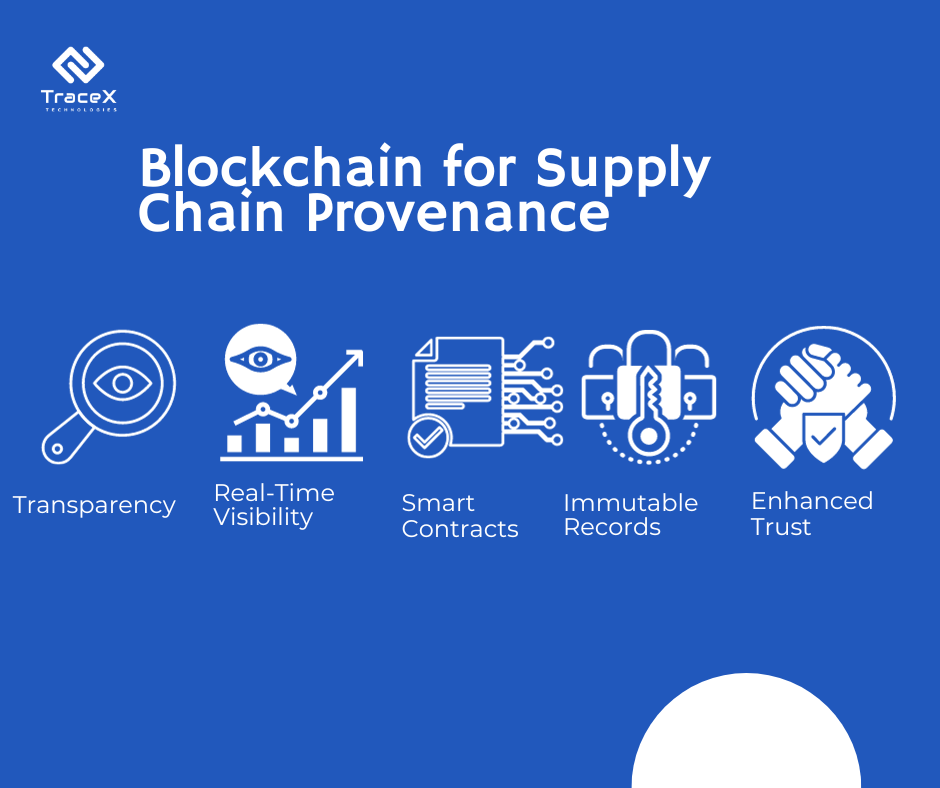Contact: +91 99725 24322 |
Menu
Menu
Quick summary: Discover the five essential elements of supply chain provenance and learn how they can help businesses enhance transparency, accountability, and sustainability in their operations.

Today consumers and regulators demand transparency, and supply chain provenance is no longer optional—it’s essential. Without clear tracking of a product’s journey, companies risk compliance challenges, reputational harm, and customer mistrust. Provenance is built on five core elements: Origin Identification, Production Process Details, Transparency, Traceability, and Compliance Verification.
The saying “you are what you eat” holds more significance for consumers now than ever before. A notable finding from NielsenIQ’s 2017 global sustainability survey reveals that 67% of consumers desire complete transparency about the ingredients in their food. Moreover, 46% of Americans report that labeling claims on food products significantly affect their buying choices.
Together, these elements offer a roadmap to responsible sourcing, fostering trust and accountability at every step. Embracing these principles transforms complex supply chains into transparent, traceable, and compliant systems.
With TraceX blockchain traceability solutions, you can trust that your supply chain data is secure, transparent, and tamper-proof, ensuring the authenticity of your products and processes.
Key Takeaways
Supply chain provenance is the art of tracing a product’s origins and its journey along the supply chain. In our modern, intricate, and interconnected supply chain landscape, it has taken on a new level of importance.
Globalized supply chains have brought both opportunities and challenges, the risk of counterfeit and fraudulent products infiltrating the market is on the rise. This is where supply chain provenance steps in as a powerful solution.
For companies, an intelligently designed supply chain provenance strategy is more than risk mitigation; it’s a trust-building tool. By ensuring the integrity of their products and their journey to the market, companies nurture trust and confidence among their customer base.
Supply chain provenance involves tracing the origins of goods and materials within a supply chain, along with their “chain of custody.” Effectively managing the risks associated with supply chain provenance is essential for organizations in both the public and private sectors. Businesses that neglect these risks may experience detrimental effects, including financial losses, operational interruptions, damage to their reputation, and potential legal issues. For government entities, the implications can extend to wider economic concerns, national security issues, and societal consequences.
Supply chain provenance is all about ensuring products are tracked, traced, and verified across their journey from origin to the end user.
Origin Identification is a foundational aspect of supply chain provenance that involves pinpointing the exact origin of each component that goes into a product, from raw materials to finished items. By accurately tracing where every element originates, companies can ensure responsible sourcing and ethical production. This approach supports transparency by confirming the source, location, and environmental impact of raw materials. For instance, in food or fashion, origin identification helps brands make informed choices, promoting sustainable practices and helping meet regulatory standards for responsible sourcing.
Production Process Details is about documenting each step in the manufacturing journey, covering the methods, standards, and certifications at every stage. By keeping track of the entire production process, companies can guarantee that their products meet specific quality and safety requirements. This documentation creates consistency across batches and ensures that the product aligns with regulatory and ethical standards. Having clear records also makes it easier to trace any issues back to their source, boosting transparency and reliability, which is critical for consumer trust and compliance.
It is rightly said, “Transparency greatly reduces “surprises” in the supply chain. Talk, Communicate, Share, Collaborate.”
Supply Chain Transparency involves providing visibility at every step of the supply chain, from suppliers to end consumers. This transparency reveals hidden risks, such as unethical sourcing practices, and builds trust by making processes open for inspection and verification. For companies, transparency helps mitigate risks, ensures ethical practices, and enhances accountability, fostering stronger relationships with consumers who value clarity about the origins and handling of the products they purchase.
Product Traceability Mechanisms involve the use of advanced technology to track the movement of each product throughout the supply chain, enhancing security and accountability. Blockchain is key for provenance tracking, as it creates a permanent, tamper-proof record of every step. Each transaction is timestamped and verified, making unauthorized changes nearly impossible. Additionally, QR codes and digital certificates enable consumers to access detailed origin data with a quick scan, building transparency and trust by verifying the product’s authenticity and journey from source to shelf. Digital provenance tracking solutions use technology to ensure every step in a product’s journey is verifiable and transparent. Through secure tools like blockchain, companies can create an immutable record that captures details at each stage of the supply chain. With digital certificates and QR codes, consumers can access information on the product’s origin, ensuring authenticity and compliance. These digital solutions not only prevent fraud and unauthorized substitutions but also build consumer trust by providing a clear, accessible history of each product’s path from source to shelf.
Compliance and authenticity verification is crucial for ensuring that products adhere to regulatory standards and meet consumer expectations. This element involves systematic checks that confirm a product’s quality and safety, which is increasingly important as consumers become more aware of sourcing practices. By verifying compliance, companies can avoid legal pitfalls while also fostering trust with their customers. This transparency not only enhances brand credibility but also ensures that products are genuinely what they claim to be, leading to stronger customer loyalty and satisfaction.
The incorporation of these five elements into supply chain provenance offers a myriad of benefits:
In agribusiness and food supply chains, various personas face distinct pain points regarding provenance:
Implementing these technologies and systems can be expensive, particularly for smaller businesses or those with extensive supply chains. Integrating these elements into existing supply chains can be complex and may require substantial planning and adjustments to current systems. Protecting sensitive product data from cyber threats and ensuring its authenticity is paramount for maintaining the security and integrity of the supply chain.
Blockchain technology has emerged as a game-changing solution in the realm of supply chain provenance. It offers a decentralized and secure ledger for tracking products at every stage of the supply chain. Blockchain provides an immutable record of transactions, enhancing transparency, traceability, and data security.

Moreover, such a framework can significantly boost consumer confidence in their purchases by furnishing a transparent record of a product’s journey throughout the supply chain.
A Spice Tech company enhanced its online platform by integrating TraceX blockchain traceability solutions, transforming it into a secure and transparent marketplace. This upgrade empowers farmers and provides verified data, fostering trust throughout the spice supply chain. As a result, the industry moves toward greater sustainability and ethical practices.
TraceX’s blockchain food traceability platform empowers companies to overcome supply chain provenance challenges by providing a secure and transparent system for tracking products from farm to table. It enables real-time data access, ensuring accurate origin identification and documenting the production process. This enhances supply chain transparency and fosters trust among stakeholders. The platform’s immutable records and use of digital certificates facilitate compliance with regulatory requirements and verify product authenticity, ultimately supporting sustainable sourcing practices and improving brand reputation.
Incorporating the five elements of supply chain provenance—origin identification, production process details, supply chain transparency, traceability mechanisms, and compliance verification—empowers businesses to build a more resilient and trustworthy supply chain. By leveraging advanced technologies like blockchain, companies can enhance accountability, foster consumer trust, and meet regulatory demands. As the market shifts towards sustainability, prioritizing provenance is not just beneficial; it’s essential for long-term success.
Supply chain provenance refers to the ability to trace the origin and journey of a product through its entire supply chain, ensuring transparency and authenticity.
Traceability helps businesses identify risks, comply with regulations, and build consumer trust by providing clear visibility into the sourcing and production processes.
Blockchain technology provides an immutable record of transactions, ensuring that product movements are securely documented and easily verifiable, thereby enhancing overall supply chain integrity.
